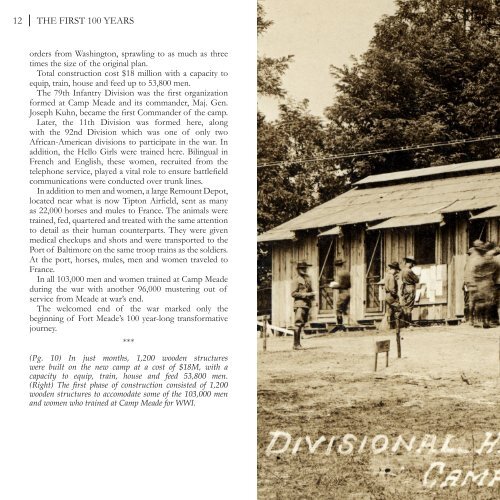Fort George G. Meade: The First 100 Years
You may know Fort George G. Meade as a cyber and intelligence hub, but did you know that the installation used to be the home of Army Tank School after World War I? Or that it housed an internment camp at the start of World War II for primarily German-American and Italian-American citizens and foreign nationals? Learn more about the fascinating history of the third largest Army base in the U.S. in terms of number of workforce in this book.
You may know Fort George G. Meade as a cyber and intelligence hub, but did you know that the installation used to be the home of Army Tank School after World War I? Or that it housed an internment camp at the start of World War II for primarily German-American and Italian-American citizens and foreign nationals? Learn more about the fascinating history of the third largest Army base in the U.S. in terms of number of workforce in this book.
You also want an ePaper? Increase the reach of your titles
YUMPU automatically turns print PDFs into web optimized ePapers that Google loves.
12 THE FIRST <strong>100</strong> YEARS<br />
orders from Washington, sprawling to as much as three<br />
times the size of the original plan.<br />
Total construction cost $18 million with a capacity to<br />
equip, train, house and feed up to 53,800 men.<br />
<strong>The</strong> 79th Infantry Division was the first organization<br />
formed at Camp <strong>Meade</strong> and its commander, Maj. Gen.<br />
Joseph Kuhn, became the first Commander of the camp.<br />
Later, the 11th Division was formed here, along<br />
with the 92nd Division which was one of only two<br />
African-American divisions to participate in the war. In<br />
addition, the Hello Girls were trained here. Bilingual in<br />
French and English, these women, recruited from the<br />
telephone service, played a vital role to ensure battlefield<br />
communications were conducted over trunk lines.<br />
In addition to men and women, a large Remount Depot,<br />
located near what is now Tipton Airfield, sent as many<br />
as 22,000 horses and mules to France. <strong>The</strong> animals were<br />
trained, fed, quartered and treated with the same attention<br />
to detail as their human counterparts. <strong>The</strong>y were given<br />
medical checkups and shots and were transported to the<br />
Port of Baltimore on the same troop trains as the soldiers.<br />
At the port, horses, mules, men and women traveled to<br />
France.<br />
In all 103,000 men and women trained at Camp <strong>Meade</strong><br />
during the war with another 96,000 mustering out of<br />
service from <strong>Meade</strong> at war’s end.<br />
<strong>The</strong> welcomed end of the war marked only the<br />
beginning of <strong>Fort</strong> <strong>Meade</strong>’s <strong>100</strong> year-long transformative<br />
journey.<br />
***<br />
(Pg. 10) In just months, 1,200 wooden structures<br />
were built on the new camp at a cost of $18M, with a<br />
capacity to equip, train, house and feed 53,800 men.<br />
(Right) <strong>The</strong> first phase of construction consisted of 1,200<br />
wooden structures to accomodate some of the 103,000 men<br />
and women who trained at Camp <strong>Meade</strong> for WWI.


